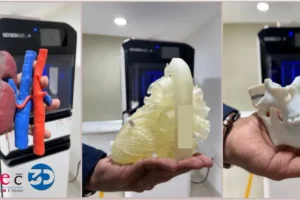The loudest revolutions don’t always begin with a bang. Some start silently, layer by layer. That’s exactly what’s happening with 3D printing in the world of healthcare. Once confined to prototyping labs, this technology has now entered operating rooms, clinics, and even hospital supply chains, quietly transforming the way doctors plan, treat, and heal.
Here are 5 subtle yet revolutionary ways 3D printing is changing the face of modern medicine and what the future holds.
3D-Printed Organ Models
Surgeons preparing for a complicated procedure used to rely on 2D scans and their imagination. 3D printed organ models now allow them to hold replicas of the patient’s anatomy, which they need to work on before the first incision is made.
These models enable the surgical teams to visualize and simulate critical steps in defending vital surgical maneuvers. Whether it’s a delicate brain tumor, an intricate heart valve, or a complicated spinal deformity, rehearsals can be conducted, and confidence is boosted.
These models are now being used by hospitals across the globe for:
- Pre-surgical planning
- Patient education
- Resident training
- Multi-departmental coordination
- Multi-disciplinary coordination.
These models are indeed lifesavers, and they are also looking to be revolutionary in saving a higher number of lives.
Precise 3D Surgical Guides
3D surgical guides make the difference as to whether a complicated surgical procedure results in success or failure. Precision is critical, and these custom-printed tools created through patient imaging do the trick.
When it comes to diagnosing and aiding with surgical procedures, patients are often conjoined with surgical biopsies. To shave the patient’s tissue or bone, these guides are fixed onto the bone, guided by the bone tissue, and assist with the surgical tools for setting the angle. 3D guides are printed with the appropriate angle to operate, ensuring zero guesswork. In:
- Orthopedic reconstructive surgeries
- Placement of dental implants
- Resection of tumors
Replacement of joints
These guides, which perform in-surgery action precision execution of pre-operative plans, make custom fitting faster, reduce recovery time, and optimization deviations from the desired outcome more uniform.
Prosthetic limbs and augmentation implants
No one-size solution exists. That’s where custom-fit prosthetic limbs and customized medical implants come into play. 3D printing enables clinicians to create prosthetics that are lightweight, anatomically tailored, and far more comfortable than conventional versions. For children or amputees with evolving needs, this means faster turnaround and easier replacements at a fraction of the cost.
Similarly, customized medical implants—like cranial plates, jawbones, or spinal cages—can be printed to match a patient’s exact dimensions, promoting better integration and long-term outcomes.
Applications include:
- Craniofacial reconstructions
- Orthopedic trauma implants
- Maxillofacial surgeries
- Dental bridges and crowns
Customization isn’t just a bonus—it’s now the standard of care in many progressive medical centers.
Functional Aids: Customized Protective Devices and Hearing Assistive Tech
Beyond surgeries and implants, 3D printing in hospitals is increasingly used to create protective medical devices, such as orthoses, splints, and braces, adapted exactly to the contours of each patient’s body.
This level of customization reduces friction injuries, improves mobility, and enhances user comfort. For instance:
- Orthotic foot braces for children with cerebral palsy
- Lightweight wrist splints for post-stroke recovery
- Sport-specific recovery gear for injured athletes
Moreover, 3D printing has been instrumental in creating shell casings and frames for Bone Anchored Hearing Aids (BAHA)—ensuring better fit and aesthetics for patients with hearing loss.
These devices might seem small in scope, but they make a huge difference in daily functionality and patient dignity.
The Future Is (Almost) Here: Bioprinting Human Tissues
Perhaps the most exciting frontier of all is bioprinting human tissues. This evolving branch of 3D printing uses bio-inks composed of living cells to print tissues that mimic the structure and function of human organs.
While we’re not yet printing fully functional organs for transplant, research labs have already printed:
- Skin grafts for burn victims
- Cartilage for joint repair
- Vascular networks for tissue growth
- Liver and kidney tissue for drug testing
These developments hint at a not-so-distant future where 3D-printed organs could reduce transplant waiting lists or even eliminate organ shortages.
In parallel, tissue engineering is progressing rapidly, combining 3D printed scaffolds with stem cells to regenerate damaged tissues inside the body.
Hospitals Are Also Becoming Mini-Factories
More hospitals and medical centers are building in-house 3D printing labs to meet daily demands. Whether it’s printing a batch of surgical jigs, prototyping a new ventilator component, or designing a patient-specific implant, 3D printing in hospitals is no longer a futuristic dream—it’s a current practice.
This shift offers several benefits:
- Faster response during emergencies
- Reduced dependence on external vendors
- Greater flexibility in innovation and design
- Cost control
- Better inventory management
Quiet but Revolutionary
3D printing may not always make headlines, but its presence in healthcare is unmistakable and growing fast. From 3D surgical guides and custom-fit prosthetic limbs to bioprinting human tissues, this technology is empowering doctors and transforming patient experiences—quietly, efficiently, and layer by layer.
And as the technology becomes more accessible and integrated into mainstream care, its quiet revolution will only grow louder.
Curious about how your hospital or clinic can start using 3D printing in patient care? The future is already being printed—make sure you’re part of it.




